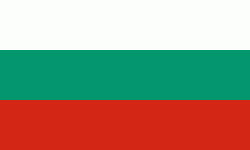Pliska
Pliska (Плиска, Пльсковъ) was the first capital of the First Bulgarian Empire during the Middle Ages and is now a small town in Shumen Province, on the Ludogorie plateau of the Danubian Plain, 20 km northeast of the provincial capital, Shumen.
Pliska was the first capital of Bulgaria, and according to legend founded by Asparuh of Bulgaria in the late 7th century; this legend is archaeologically unsubstantiated. The site was originally an encampment, with the first tent-shaped buildings at Pliska of uncertain date. No evidence exists of a settlement before the 9th century, and claims that the site dates from Late Antiquity have been contested.
By the early 9th century, Pliska was surrounded by a defensive wall and 2,300 hectare of land was further enclosed by an outer earthwork with stone revetment 21 km long. After the Byzantine army sacked and burned Pliska in 811, led by the emperor Nikephoros I ((r. 802 – 811)), Pliska was rebuilt by Omurtag ((r. 814 – 831)), who used spolia from nearby Roman buildings and employing late Roman-inspired rectilinear and basilica plans in the architecture of his new ashlar palace, which descended from Late Antique prototypes like Diocletian's Palace at Split, Croatia. When Boris I ((r. 852 – 889)) converted to Christianity in 864, the religious buildings of Pliska were adapted for Christian use and it was after this point that the Great Basilica was constructed, together with a monastery which was attached to it. The monastery was home to the disciples of Saints Cyril and Methodius.
After the tsar Simeon I founded his new capital at Preslav, Pliska was slowly abandoned. Pliska was captured at the turn of the 2nd millennium by Theodorokanos and Nikephoros Xiphias, during the campaigns of the emperor Basil the Bulgar-Slayer ((r. 960 – 1025)), which ended the First Bulgarian Empire.
Pliska was the first capital of Bulgaria, and according to legend founded by Asparuh of Bulgaria in the late 7th century; this legend is archaeologically unsubstantiated. The site was originally an encampment, with the first tent-shaped buildings at Pliska of uncertain date. No evidence exists of a settlement before the 9th century, and claims that the site dates from Late Antiquity have been contested.
By the early 9th century, Pliska was surrounded by a defensive wall and 2,300 hectare of land was further enclosed by an outer earthwork with stone revetment 21 km long. After the Byzantine army sacked and burned Pliska in 811, led by the emperor Nikephoros I ((r. 802 – 811)), Pliska was rebuilt by Omurtag ((r. 814 – 831)), who used spolia from nearby Roman buildings and employing late Roman-inspired rectilinear and basilica plans in the architecture of his new ashlar palace, which descended from Late Antique prototypes like Diocletian's Palace at Split, Croatia. When Boris I ((r. 852 – 889)) converted to Christianity in 864, the religious buildings of Pliska were adapted for Christian use and it was after this point that the Great Basilica was constructed, together with a monastery which was attached to it. The monastery was home to the disciples of Saints Cyril and Methodius.
After the tsar Simeon I founded his new capital at Preslav, Pliska was slowly abandoned. Pliska was captured at the turn of the 2nd millennium by Theodorokanos and Nikephoros Xiphias, during the campaigns of the emperor Basil the Bulgar-Slayer ((r. 960 – 1025)), which ended the First Bulgarian Empire.
Map - Pliska
Map
Country - Bulgaria
 |
 |
| Flag of Bulgaria | |
One of the earliest societies in the lands of modern-day Bulgaria was the Neolithic Karanovo culture, which dates back to 6,500 BC. In the 6th to 3rd century BC the region was a battleground for ancient Thracians, Persians, Celts and Macedonians; stability came when the Roman Empire conquered the region in AD 45. After the Roman state splintered, tribal invasions in the region resumed. Around the 6th century, these territories were settled by the early Slavs. The Bulgars, led by Asparuh, attacked from the lands of Old Great Bulgaria and permanently invaded the Balkans in the late 7th century. They established the First Bulgarian Empire, victoriously recognised by treaty in 681 AD by the Eastern Roman Empire. It dominated most of the Balkans and significantly influenced Slavic cultures by developing the Cyrillic script. The First Bulgarian Empire lasted until the early 11th century, when Byzantine emperor Basil II conquered and dismantled it. A successful Bulgarian revolt in 1185 established a Second Bulgarian Empire, which reached its apex under Ivan Asen II (1218–1241). After numerous exhausting wars and feudal strife, the empire disintegrated and in 1396 fell under Ottoman rule for nearly five centuries.
Currency / Language
| ISO | Currency | Symbol | Significant figures |
|---|---|---|---|
| BGN | Bulgarian lev | лв | 2 |
| ISO | Language |
|---|---|
| BG | Bulgarian language |
| TR | Turkish language |















